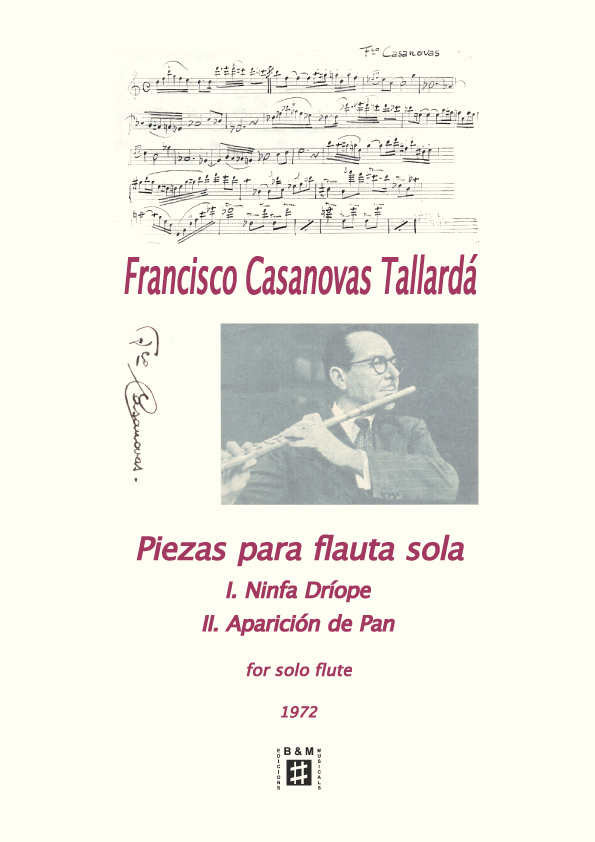Description
Author
Instrumentation
Duration
Pages
Year of composition
ISMN
Ref.
On February 8 1972, Casanovas was invited by the director of the Conservatorio Superior de Musica de Valencia, his friend and composer Amando Blanquer Ponsoda, to take part in the ninth session of the 1971–72 lecture and concert series. Casanovas gave a lecture entitled Musical Activity in India. It addressed his long musical career in India, his collaboration with Rabindranath Tagore, the main features of Indian thematic material and harmonization, as well as the challenges posed by Europeanization. The musical illustrations were performed by Casanovas himself on the flute, including Indian ragas and ragginis, a raga panchana, and the premiere of his Three Pieces for Solo Flute: Nymph Dríope, Appearance of Pan, and Repose.
Nymph Dríope is the first of these Three Pieces for Solo Flute. Dríope is a character from Greek mythology. There are various versions of her story; the most widely known recounts that she was not actually a nymph, but the only daughter of King Driops. She tended his flocks near Mount Oeta and became friends with the Hamadryads—tree nymphs—from whom she learned hymns and dances pleasing to the gods. According to Ovid in his Metamorphoses, Dríope went to a mountain to offer a sacrifice in honour of the nymphs. Blinded by the dazzling flowers of a tree, she picked some, unaware that the tree was in fact the nymph Lotis. Lotis, angered, transformed her into a similar tree.
This story bears a striking resemblance to that of Syrinx, the nymph who was transformed into a river reed to escape the lustful pursuit of the god Pan. Some authors have confused the two, such as Virgil, who in the Aeneid refers to a nymph named Dríope loved by Faunus—a story clearly reminiscent of Syrinx and Pan.
To compose Nymph Dríope, Casanovas drew inspiration from the Capriccio for solo flute by his friend Robert Gerhard, who had dedicated the piece to him in 1949 during one of his returns to Barcelona from India. However, Casanovas gave it a less dodecaphonic and more neo-impressionist and oriental style.
Appearance of Pan is the second of his Three Pieces for Solo Flute. It displays a distinctly Oriental and Neo-Impressionist style. The title alludes to the moment in Greek mythology when the god Pan appears on a mountain in Arcadia and begins to amorously pursue a nymph named Syrinx. The theme recalls Debussy’s Pan’s Flute, published as Syrinx by editor Jobert in the first edition of 1927. It is worth remembering that this piece was premiered in Paris in 1913 by Casanovas’s teacher, Louis Fleury, from whom he learned this renowned musical work. Appearance of Pan is based on motifs from his symphonic work Ellen’s Vision. Impression Orientale, premiered on January 26, 1941, with the Calcutta Symphony Orchestra.
Gerhard praised Casanovas as a wind multi-instrumentalist with the following words:
“Casanovas’s excellence as a saxophonist, flautist, and clarinettist definitively destroys the persistent myth of the lip enslaved to a single instrument. The saxophone embouchure does not ruin his lip for the flute, nor vice versa. The execution of the rapid tongue tremolo, the Flatterzunge of the Germans, which he masters perfectly not only on the flute, but also on the clarinet—a feat still considered impossible by many clarinettists—and even on the saxophone (!), clearly has no harmful effect on the stability of his embouchure.” (Mirador, March 1930)
Juan Francisco Cayuelas Grao




















There are no reviews yet.